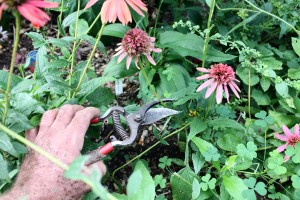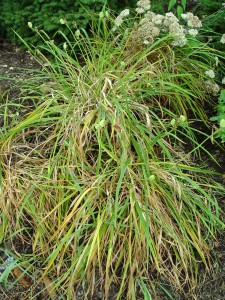Summer Care Secrets
June 9th, 2015
If you’ve ever gone away on a 2-week summer vacation, you know it doesn’t take long for a yard to go down the tubes.
The grass gets overgrown, weeds seem to grow 2 feet tall overnight, and assorted plants cry out for trimming, de-flopping, deadheading and other “primping.”
Regular maintenance, in other words, is absolutely critical for keeping a yard looking good throughout the season. Even the best design quickly falls apart without good care.
I like to go on regular patrols in which I “inspect the troops.” That’s instead of the occasional major blowout cleanups that many people do.
I think it’s much easier to stay on top of a yard’s jungle tendencies by frequent, light policing rather than letting things get out of control and then struggling to recover.
Besides, little weeds come out much easier than big ones. And the patrols give me an excuse to sniff the posies and enjoy the season’s progress while I’m out there looking for trouble.
Knowing what to do – plus when and how to do it – is the key to good care. But since no one learns that in school and since not everyone had a gardening-savvy parent or grandparent to show them, I thought I’d share a few care tips that I employ in summer.
* Flop prevention. The time to get those plant supports in place is now, not later. Tall, bushy plants like peonies, rudbeckia, boltonia and irises often lean or flop without support.
It’s much easier to get supports in place and let the plants grow into or onto them as opposed to trying to corral a flopper later.
One of my favorite strategies is to jam three bamboo stakes around a plant and tie a couple of levels of green jute around them to create a sort of “plant girdle.”
* De-sizing trims. Another flop-preventer is trimming late-blooming perennials that tend to get too tall.
Best known is mums, but asters, sedum, goldenrod and boltonia are other late-season bloomers that often flop under the weight of flowers atop long stems.
Gardeners are usually told they can stop this by “pinching,” which they take to mean using their fingers to pinch back the tips of branches one by one.
Forget that. Just shear the whole plant back by one-half to one-third. You can actually do it two or three times… just knock it off by the end of June so flower buds have time to form.
Mums are the best known plant for this kind of pruning, but it’s also useful for most any perennial that’s flop-prone with a bloom time after Labor Day.
The cut plants will look bad right after the trim, but they’ll be much more compact and nicer in bloom come late summer and fall.
* Trim the early bloomers. Most spring-blooming perennials look best with a cutback right after they flower.
This ranges from a light trim to remove spent flowers on dense bloomers such as dianthus, candytuft and creeping phlox to removing whole flower stems and shortening overly long stems on varieties such as salvia, Shasta daisy, foamflowers, catmint and coralbells.
First of all, trimming off browned flowers makes the plant look neater. But it sometimes triggers a repeat later-season bloom, especially salvia and catmint, and makes your plants more compact the rest of the season since it’s that spring spurt that’s responsible for most a season’s growth.
I cut my catmint plants right to the base once the first bloom is done. That gives me a compact plant with fresh foliage that blooms again from late summer past frost.
* Pick off disease. Spraying is a difficult and costly way to deal with disease. I’d rather pick off the ratty leaves of diseased plants and get rid of it.
You’d be surprised how often fresh new growth occurs that doesn’t get diseased.
A prime example is the daylily, which is increasingly prone to a fungal leaf-streak disease that causes brown spots, then streaks, then whole browned-out leaves. I pull and/or clip off the diseased leaves – including right down to removing all foliage when infections get bad enough.
Within a few weeks, new shoots are up, and the fresh daylily foliage usually looks pretty good the rest of the way.
This also works (at least for me) with mildewed beebalm, phlox and coreopsis and with leaf-spotted black-eyed susans.
* Trim the evergreens. June is an ideal month to cut back overgrown evergreens and to shear evergreen hedges, such as boxwood, holly, arborvitae, juniper and yew.
If you trim off all or most of this season’s new growth, you can maintain size for decades.
Avoid letting your evergreens get so big that you have to cut back into bare wood to bring them back to size. Only a few species (yew, boxwood and holly, for example) have the ability to sprout new growth in that kind of severe whack-back.
When branches get so thick that you can’t shear anymore, start to gradually and selectively remove these big branches to allow smaller nearby branches to fill in the gaps. This kind of “thinning out” is actually good for hedges because it lets light into the interior of the plants.
* Prune the early-blooming shrubs. The time to prune spring-blooming shrubs such as lilac, azalea, weigela and rhododendron, is right after the plants are done flowering. June isn’t too late.
This is also the time to prune and deadhead the roses once they’re peak bloom winds down in mid to late June.
And when those rounded pink-blooming spireas finish blooming by late June, trim off the browned blooms (think haircut) and cut them back by up to one-third if they’re getting too big.










